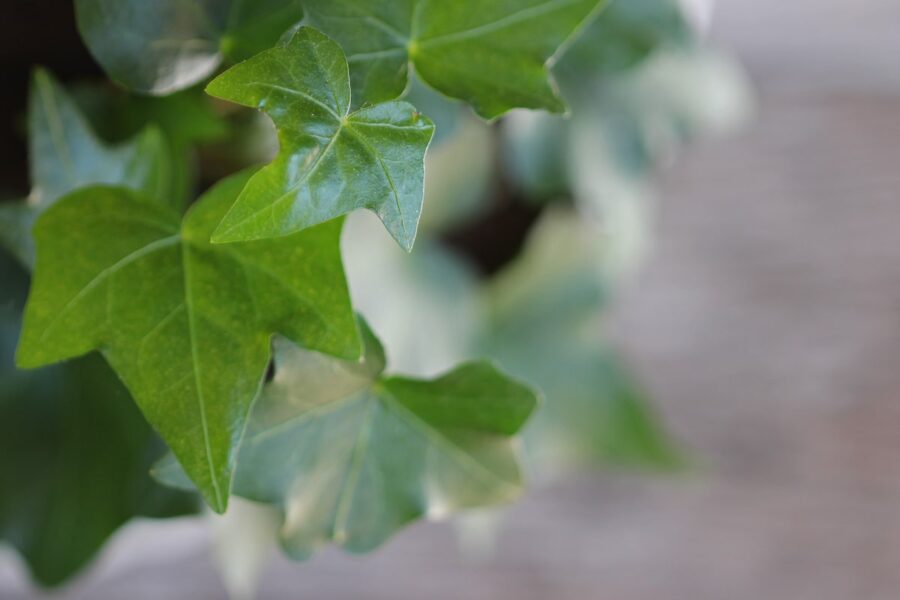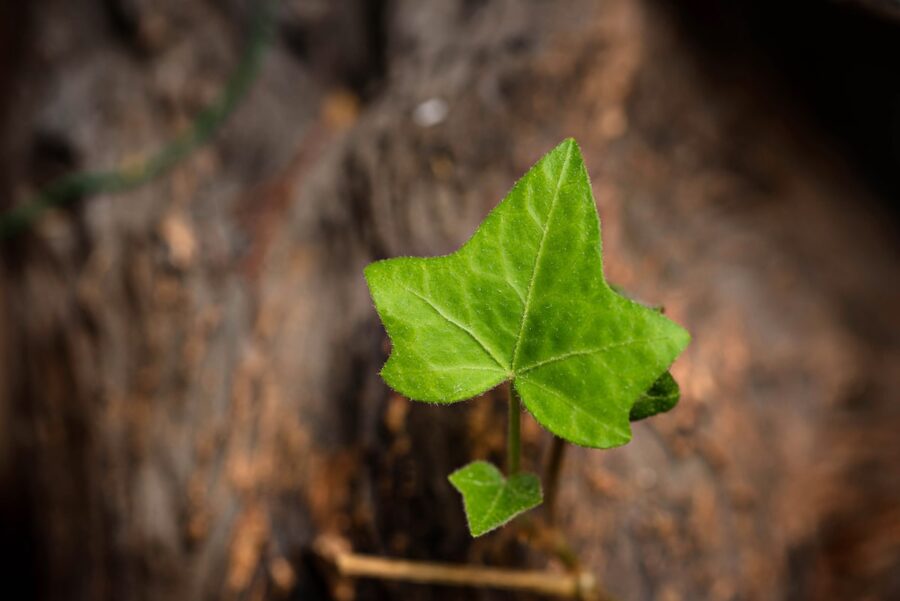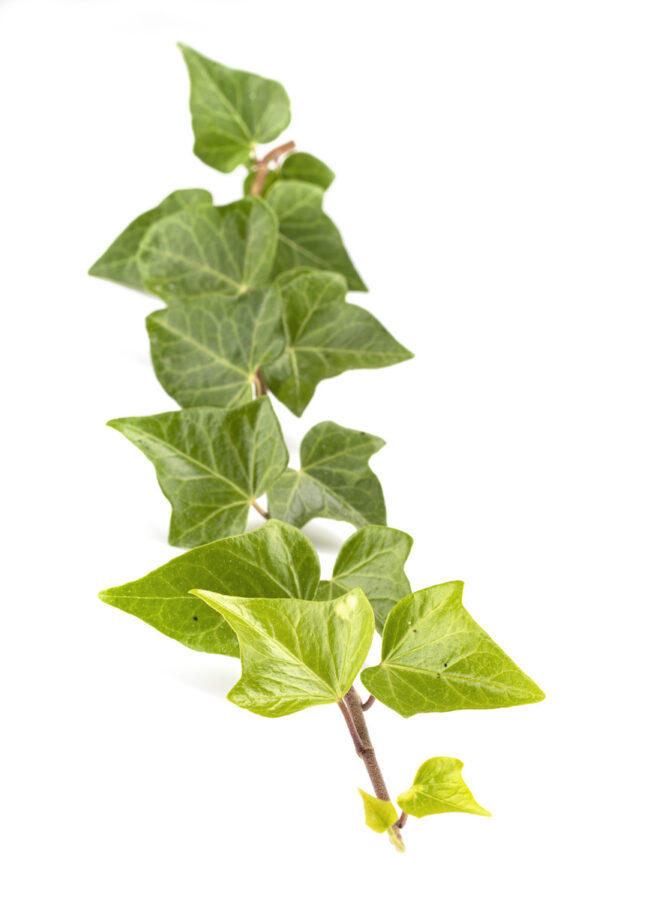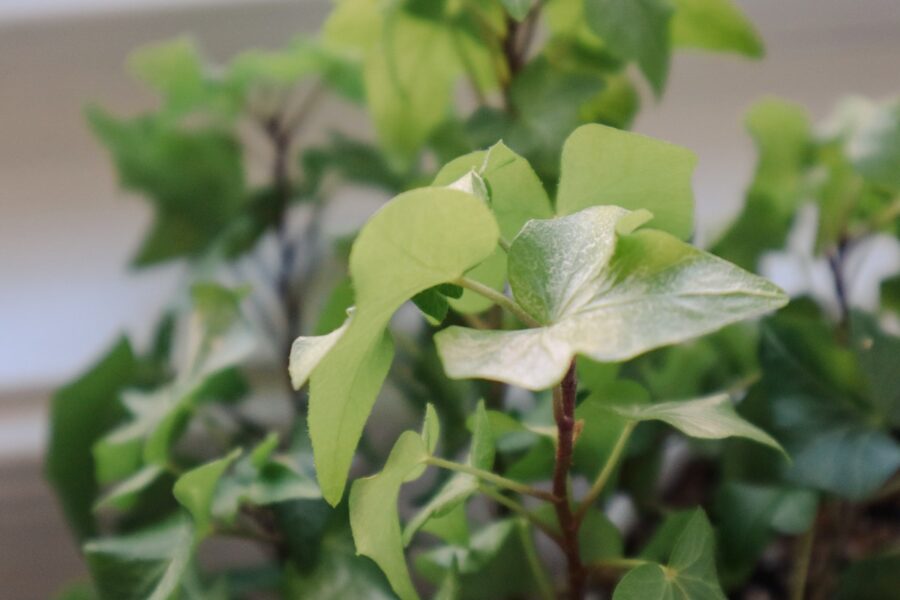English ivy, which is also known as common ivy, is a well-known plant. Most leaf lovers have admired this vine where it crept up a building wall, displaying lush evergreen foliage. Are you considering adding ivy to your plant collection? Great stuff! Our care guide tells you everything you need to know to keep this iconic perennial happy.
Table of Contents
Origins and Appearance
Despite its name, English ivy does not solely come from England. This lovely creeper is native to Europe, northeastern Ireland, southern Scandinavia, southern Spain, northern Africa and western Asia.
English ivy is an evergreen vine and perennial. This feature, coupled with its climbing abilities that can reach up to 90 feet, makes the plant a popular landscaping option. Young plants have thin stems and leaves that are divided into lobes, numbering three to five. Mature ivy has no lobes and also produce thick, woody stems. The dark green leaves have veins that are either pale green or white.
English ivy is also a flowering plant. In the fall, mature plants produce small blooms that eventually morph into dark fruit.
Temperature and Humidity
Your ivy will thrive in a room where there is lots of bright but indirect sunlight. This plant will not grow well – and can even fall ill – when exposed to direct sun or hot conditions for long periods of time. English ivy loves moderate temperatures and grows best when they are kept in a place where the temperature is between 50 to 70°F (10 to 21°C).
English ivy also does well with 40 percent relative humidity or higher. Keep an eye on the plant during winter. During this season, humidity can fall faster than a brick. If you have humidity problems (in other words, the levels are too low), then consider investing in a small humidifier to coddle your ivy.
Watering and Feeding

Water When Dry
Many new plant parents love ivy because it is beautiful and does not require constant attention. Indeed, your English ivy does not like to be overwatered and wet soil can cause a host of problems for this plant. You will know when to give water when you test the soil and find that the top layer (about an inch’s worth) is dry.
Feeding Guidelines
The feeding needs of English ivy is a bit more complex. But keep the following tips in mind and you will do just fine.
- Never fertilize your ivy in stressful situations like extremely hot or cold weather, illness, or when the entire pot’s soil had dried out
- Feed your ivy only during spring and summer
- Keep the feedings two weeks apart
- Use a high-quality organic fertilizer like fish emulsion or anything with an organic 2-2-2 formula.
Soil and Repotting

Most Options Will Do
English ivy is a grateful plant that can handle a variety of soil conditions and pH levels. This adaptability is another reason why this perennial is good for beginners and landscapers. That being said, ivy will grow best in certain types of soil. If your ivy plant is outdoors in the garden, it prefers average but well-draining loams. Indoors, you can use a well-draining potting soil mix.
How to Repot Ivy
When repotting your ivy, you can always consider placing the plant in a hanging basket. This is both a stylish way to display ivy and a means to control the plant’s habit of taking over its environment with all those creeping vines!
Keeping true to its low-maintenance reputation, English ivy does not need constant repotting. If you have a small plant (and a small pot), then you only have to change containers once a year. A larger ivy can be repotted every two years.
You don’t always have to replace the container. If your ivy still has enough space in the pot but it’s been one or two years since it was last repotted, simply change the potting soil. A new load of soil will give your plant plenty of nutrients for the next haul.
Get all the best tips on how to re-pot your house plants.
Pruning

Since English ivy is a bit boisterous, pruning is a must. Those lovely tendrils will grow and become invasive if not kept under control.
When to Prune English Ivy
Only give your plant a haircut in spring. You can pinch off the growing tips to keep the plant shapely and manageable. A hard pruning every five or six years will also give your ivy a new lease on life.
How to Prune English Ivy
Always use clean and sharp scissors to avoid infection and splintered stems. Remove all the side vines that you don’t want or trim the ivy into a bushy shape if kept in a hanging basket.
If your ivy is outdoors, you can also remove all the unwanted parts with scissors. Be careful, however, when the vines have taken over a wall or tree. Resist the urge to rip the ivy off. Trees, especially, get damaged that way. Instead, draw on a deep well of patience and carefully cut the vines away one by one!
Pests and Diseases

English ivy is a robust and healthy plant. The chances are that you will experience more issues with your other houseplants than with this species of ivy. However, there are certain bugs and diseases that like to visit English ivy, so let’s have a look at the usual suspects and their antidotes!
Common Pests
Use a good organic pesticide for all the following pests.
Apids
All plant lovers run into these goobers. Aphids are insects that like to suck the juices of plants and this can weaken the plant to the point where it becomes susceptible to disease. They can be seen with the naked eye and live in clusters along the stems and under leaves.
Spider Mites
These arachnids are harder to spot but you know their presence when you notice web-like strings on your plants.
Mealy Bugs
The name says it all. When you notice bugs with a mealy appearance – and a white powdery substance everywhere – then you are dealing with this pest. They can multiply rapidly, so take action as soon as possible.
Common Diseases and Problems
English ivy has two common issues – root rot and bacterial leaf spot. Good care can prevent both but let’s look at the main causes and symptoms of each.
Root Rot
The main cause of root rot is too much water. For this reason, keep your ivy in well-draining soil and only water when the top inch of the soil is dry. Signs include discolored leaves, severe wilting, waterlogged soil, and mushy roots. You can attempt to save the plant by repotting the ivy but truth be told; by the time symptoms appear, it is usually too late.
Bacterial Leaf Spot
This bacterial infection does not have a better prognosis. Signs include black or brown spots on the leaves. If you decide to try and save the plant, first remove it from all other plants (the condition is infectious) and treat the ivy with an organic product. Otherwise, the best option is to get rid of the ivy altogether.
FAQ

Absolutely. English ivy is ideal as a hanging houseplant due to its cascading vines and evergreen, perennial status.
English ivy can be propagated from cuttings. When you prune your plant in spring, use these cuttings to make baby ivy plants. Choose stems that are between 4 and 5 inches long and place them in water. Replace the water every few days until the cuttings grow roots and then transfer each new ivy to its own pot.
English ivy can grow rapidly and aggressively outdoors. Within months, you can have an established plant that is full of lush vines. Indoors, however, ivy can take up to a year to “settle in” before it experiences a growth spurt.
According to the ASPCA, English ivy is toxic to cats, dogs and horses. If you have horses, make sure that they don’t have access to your outdoors ivy. For indoor pets and ivy plants, keep the two separated at all times. Also, make sure that you collect all fallen leaves so that your pets do not accidentally consume them.

